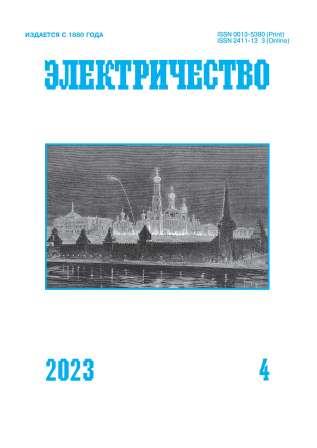Математическая модель ветроэнергоустановки на эффекте Магнуса
DOI:
https://doi.org/10.24160/0013-5380-2023-4-35-43Ключевые слова:
эффект Магнуса, ветроэнергоустановка, моделирование, коэффициент использования ветра, ветровая энергетикаАннотация
Ветроэнергоустановки, использующие эффект Магнуса, являются альтернативой традиционным лопастным установкам в регионах со слишком низким или высоким ветровым потенциалом. Особенностью их конструкции является применение вращающихся цилиндров для создания крутящего момента на валу ветроколеса. Целью исследований являлась разработка математической модели такой установки. Были рассмотрены три модели коэффициента использования энергии ветра: аналитическая, регрессионная и корреляционная. Анализ рассмотренных моделей позволил сделать выводы о границах их применимости, а также выделить основные достоинства и недостатки. Была синтезирована альтернативная имитационная аэродинамическая модель с применением метода вычислительной аэродинамики. Верификация разработанной модели проводилась путем сравнения полученных данных о генерируемой мощности имитационной модели с экспериментальными данными, полученными на реальной установке в ходе полевых испытаний. Исследования показали, что разработанная модель на основе вычислительной аэродинамики обладает высокой точностью и может использоваться для моделирования ветроэнергоустановки на эффекте Магнуса при переменном ветре. В дальнейшем представленная модель может быть использована при разработке алгоритмов обнаружения точки максимальной мощности для данного типа ветроэнергоустановок.
Библиографические ссылки
2. Alassaf O. et al. Cylindrical Blades Magnus Wind Turbine Optimization and Control System. – 29th International Workshop on Electric Drives, 2022, 10.1109/IWED54598.2022.9722582.
3. Lukin G. et al. Investigation of FEM Software for Magnus Effect Simulation. – 28th International Workshop on Electric Drives, 2021, DOI:10.1109/IWED52055.2021.9376396.
4. Bychkov N.M., Dovgal A.V., Kozlov V.V. Magnus Wind Turbines as an Alternative to the Blade Ones. – Journal of Physics: Conference Series, 2007, vol. 75(1), 012004, DOI:10.1088/1742-6596/ 75/1/012004.
5. Sedaghat A. Magnus Type Wind Turbines: Prospectus and Challenges in Design and Modelling. – Renewable Energy, 2014, vol. 62, pp. 619–628, DOI: 10.1016/j.renene.2013.08.029.
6. Jinbo M. et al. Fixed and Adaptive Step HCC Algorithms for MPPT of the Cylinders of Magnus Wind Turbines. – 3rd Renewable Power Generation Conference, 2014, DOI: 10.1049/cp.2014.0921.
7. Jinbo M. et al. MPPT of Magnus Wind System with DC Servo Drive for the Cylinders and Boost Converter. – Journal of Wind Energy, 2015, No. 2, DOI:10.1155/2015/148680.
8. Wind is Blowing to a New Direction [Электрон. ресурс], URL: https://challenergy.com/en/ (дата обращения 26.12.2022).
9. Seifert J. A Review of the Magnus Effect in Aeronautics. – Progress in Aerospace Sciences, 2012, vol. 55, pp. 17–45, DOI: 10.1016/ j.paerosci.2012.07.001.
10. Mara K. et al. Development and Validation of a CFD Model Using ANSYS CFX for Aerodynamics Simulation of Magnus Wind Rotor Blades. – International Conference on Humanoid, Nanotechnology, Information Technology, Communication and Control, Environment and Management, 2014, DOI:10.1109/HNICEM.2014.7016231.
11. ГОСТ Р 54418.1-2012 (МЭК 61400–1:2005). Возобновляемая энергетика. Ветроэнергетика. Установки ветроэнергетические. Ч. 1. Технические требования. М.: Стандартинформ, 2016, 82 c.
12. González-Hernández J.G., Salas-Cabrera R. Representation and Estimation of the Power Coefficient in Wind Energy Conversion Systems. – Revista Facultad de Ingeniería, 2019, vol. 28(50), pp. 77–90, DOI:10.19053/01211129.v28.n50.2019.8816.
13. Luo D., Huang D., Wu G. Analytical Solution on Magnus Wind Turbine Power Performance Based on the Blade Element Momentum Theory. – Journal of Renewable and Sustainable Energy, 2011, vol. 3(3), 033104, DOI:10.1063/1.3588039.
14. Richmond-Navarro G. et al. A Magnus Wind Turbine Power Model Based on Direct Solutions Using the Blade Element Momentum Theory and Symbolic Regression. – IEEE Transactions on Sustainable Energy, 2016, vol. 8(1), pp. 425–430, DOI:10.1109/TSTE.2016.2604082.
15. Richmond-Navarro G., Ureña-Sandí N., Rodríguez G. High Correlation Models for Small Scale Magnus Wind Turbines. – 5th International Conference on Renewable Energy: Generation and Applications (ICREGA), 2018, DOI:10.1109/ICREGA.2018.8337574.
#
1. Lukin G.L. et al. Experimental Prototype of High-Efficiency Wind Turbine Based on Magnus Effect. – 27th International Workshop on Electric Drives, 2020, DOI:10.1109/IWED48848.2020.9069565.
2. Alassaf O. et al. Cylindrical Blades Magnus Wind Turbine Optimization and Control System. – 29th International Workshop on Electric Drives, 2022, 10.1109/IWED54598.2022.9722582.
3. Lukin G. et al. Investigation of FEM Software for Magnus Effect Simulation. – 28th International Workshop on Electric Drives, 2021, DOI:10.1109/IWED52055.2021.9376396.
4. Bychkov N.M., Dovgal A.V., Kozlov V.V. Magnus Wind Turbines as an Alternative to the Blade Ones. – Journal of Physics: Conference Series, 2007, vol. 75(1), 012004, DOI: 10.1088/1742-6596/ 75/1/012004.
5. Sedaghat A. Magnus Type Wind Turbines: Prospectus and Challenges in Design and Modelling. – Renewable Energy, 2014, vol. 62, pp. 619–628, DOI: 10.1016/j.renene.2013.08.029.
6. Jinbo M. et al. Fixed and Adaptive Step HCC Algorithms for MPPT of the Cylinders of Magnus Wind Turbines. – 3rd Renewable Power Generation Conference, 2014, DOI: 10.1049/cp.2014.0921.
7. Jinbo M. et al. MPPT of Magnus Wind System with DC Servo Drive for the Cylinders and Boost Converter. – Journal of Wind Energy, 2015, No. 2, DOI:10.1155/2015/148680.
8. Wind is Blowing to a New Direction [Electron. resource], URL: https://challenergy.com/en/ (date of appeal 26.12.2022).
9. Seifert J. A Review of the Magnus Effect in Aeronau-tics. – Progress in Aerospace Sciences, 2012, vol. 55, pp. 17–45, DOI:10.1016/j.paerosci.2012.07.001.
10. Mara K. et al. Development and Validation of a CFD Model Using ANSYS CFX for Aerodynamics Simulation of Magnus Wind Rotor Blades. – International Conference on Humanoid, Nanotechnology, Information Technology, Communication and Control, Environment and Management, 2014, DOI:10.1109/HNICEM.2014.7016231.
11. GОSТ R 54418.1-2012 (IEC 61400–1: 2005). Vozobnov-lyaemaya energetika. Vetroenergetika. Ustanovki vetroenergeticheskie. Ch. 1. Tekhnicheskie trebovaniya (Renewable Power Engineering. Wind Power Engineering. Wind turbines. Part 1. Technical Requirements). М.: Standartinform, 2016, 82 p.
12. González-Hernández J.G., Salas-Cabrera R. Representation and Estimation of the Power Coefficient in Wind Energy Conversion Systems. – Revista Facultad de Ingeniería, 2019, vol. 28(50), pp. 77–90, DOI:10.19053/01211129.v28.n50.2019.8816.
13. Luo D., Huang D., Wu G. Analytical Solution on Magnus Wind Turbine Power Performance Based on the Blade Element Momentum Theory. – Journal of Renewable and Sustainable Energy, 2011, vol.3(3), 033104, DOI:10.1063/1.3588039.
14. Richmond-Navarro G. et al. A Magnus Wind Turbine Power Model Based on Direct Solutions Using the Blade Element Momentum Theory and Symbolic Regression. – IEEE Transactions on Sustainable Energy, 2016, vol. 8(1), pp. 425–430, DOI:10.1109/TSTE.2016.2604082.
15. Richmond-Navarro G., Ureña-Sandí N., Rodríguez G. High Correlation Models for Small Scale Magnus Wind Turbines. – 5th International Conference on Renewable Energy: Generation and Applications (ICREGA), 2018, DOI:10.1109/ICREGA.2018.8337574.




